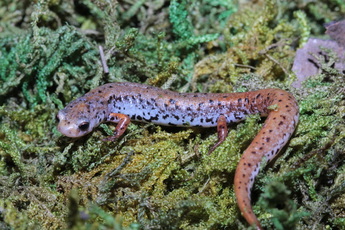
Distribution, Abundance, and Recruitment of Amphibian SGNCs
Ephemeral and semi-permanent wetlands that lack fish provide essential habitat for many amphibian species. Within Illinois, over 90% of these historical wetlands have been lost. This has contributed to concern for apparent local amphibian extinctions and widespread decreases in abundance. Further, recruitment rates into the adult population are not well understood but believed to be low. In this study, using standard minnow traps and dip net protocols, we are sampling over 30 wetlands throughout the Vermilion County to 1. Identify breeding ponds used by Silvery Salamander, Four-toed Salamander and Wood Frog. 2. assess abundance of adults during the breeding season, as well as late stage larvae to determine general distribution, abundance and recruitment rates. Additionally, we have fully fenced 6 ponds (4 recently created and 2 reference ponds) to quantify demographic patterns inf individuals using the wetlands, determine how climatic and environmental variables affect pond use, recruitment and productivity, and ascertain if created wetlands are functioning similarly to reference wetlands.
Ephemeral and semi-permanent wetlands that lack fish provide essential habitat for many amphibian species. Within Illinois, over 90% of these historical wetlands have been lost. This has contributed to concern for apparent local amphibian extinctions and widespread decreases in abundance. Further, recruitment rates into the adult population are not well understood but believed to be low. In this study, using standard minnow traps and dip net protocols, we are sampling over 30 wetlands throughout the Vermilion County to 1. Identify breeding ponds used by Silvery Salamander, Four-toed Salamander and Wood Frog. 2. assess abundance of adults during the breeding season, as well as late stage larvae to determine general distribution, abundance and recruitment rates. Additionally, we have fully fenced 6 ponds (4 recently created and 2 reference ponds) to quantify demographic patterns inf individuals using the wetlands, determine how climatic and environmental variables affect pond use, recruitment and productivity, and ascertain if created wetlands are functioning similarly to reference wetlands.

Collaborators: John A. Crawford, Bill Peterman, & Christopher A. Phillips
Sponsor: Illinois Department of Natural Resources, State Wildlife Grant
Collaborators: John A. Crawford, Bill Peterman, & Christopher A. Phillips
Sponsor: Illinois Department of Natural Resources, State Wildlife Grant
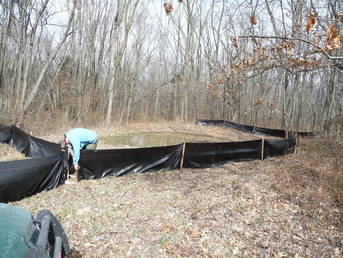
Assessment of Wetland Quality on Illinois Public Lands
The Illinois Wildlife Action Plan of 2005 calls for the development of monitoring methods and an updated assessment of wetland habitat in Illinois. For this project, we are developing a rapid assessment methodology that evaluates the ecological health and function of seasonal and semi-permanent wetlands on publicly managed lands in Illinois. We are developing an Index of Biological Integrity (IBI) that incorporates information from amphibians, reptiles, and macro-invertebrates in seasonal and semi-permanent wetlands. We anticipate that the results of this work will provide state officials and land managers who need to assess wetland function for wildlife, recommendation on areas of the state in which wetlands are deficient and, as such, candidates for wetland restoration and creation, and contribute to the management plans for threatened and endangered amphibian, reptile, and macro-invertebrate species throughout Illinois.
The Illinois Wildlife Action Plan of 2005 calls for the development of monitoring methods and an updated assessment of wetland habitat in Illinois. For this project, we are developing a rapid assessment methodology that evaluates the ecological health and function of seasonal and semi-permanent wetlands on publicly managed lands in Illinois. We are developing an Index of Biological Integrity (IBI) that incorporates information from amphibians, reptiles, and macro-invertebrates in seasonal and semi-permanent wetlands. We anticipate that the results of this work will provide state officials and land managers who need to assess wetland function for wildlife, recommendation on areas of the state in which wetlands are deficient and, as such, candidates for wetland restoration and creation, and contribute to the management plans for threatened and endangered amphibian, reptile, and macro-invertebrate species throughout Illinois.

Collaborators: John A. Crawford & Christopher A. Phillips
Sponsor: U.S. Environmental Protection Agency; Region 5 Wetlands Development Program Grant
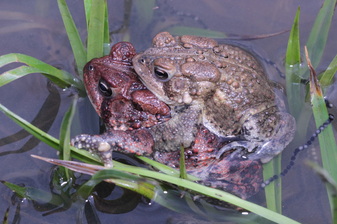
Ecological Assessment of Created Wetlands in Illinois
Wetland creation was listed as a priority campaign in the Illinois Wildlife Action Plan in 2005. Since then, more than 250 seasonal wetlands have been created on state managed properties in east central Illinois. We are sampling 60 of these wetlands (broken into three age groups) as well as 20 reference wetlands to examine wetland health and function. To do so, we are examining plant diversity, amphibian diversity, and standard water chemistry variables. The project design is incorporating repeated amphibian surveys to allow for estimates of occupancy and detectability. All components will be incorporated into an index of biological integrity (IBI) to provide an initial assessment of created and reference wetlands in east-central Illinois.
Wetland creation was listed as a priority campaign in the Illinois Wildlife Action Plan in 2005. Since then, more than 250 seasonal wetlands have been created on state managed properties in east central Illinois. We are sampling 60 of these wetlands (broken into three age groups) as well as 20 reference wetlands to examine wetland health and function. To do so, we are examining plant diversity, amphibian diversity, and standard water chemistry variables. The project design is incorporating repeated amphibian surveys to allow for estimates of occupancy and detectability. All components will be incorporated into an index of biological integrity (IBI) to provide an initial assessment of created and reference wetlands in east-central Illinois.

Collaborators: John A. Crawford & Paige Mettler-Cherry
Sponsor: U.S. Environmental Protection Agency; Region 5 Wetlands Development Program Grant
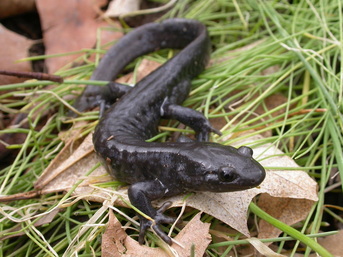
Conservation Genetics of Jefferson Salamander in Illinois: Implications for conservation and recovery
Amphibians are generally thought to have poor dispersal abilities and because of this, even low levels of habitat fragmentation may result in the isolation of previously connected populations. The subdivision of a large panmictic population into several smaller, isolated populations makes populations (and species) more vulnerable to extirpation. Therefore, successful conservation of species in highly fragmented landscapes requires information on patterns of gene flow (i.e. connectivity) among populations. Jefferson salamanders (Ambystoma jeffersonianum) are considered a species of conservation concern over portions of their range and are listed as a state threatened species in Illinois. We used 11 polymorphic microsatellite loci to determine the genetic population structure of Jefferson salamanders breeding at 16 ponds in east-central Illinois, which is a landscape fragmented by agriculture. Our objectives were to estimate the amount of genetic differentiation among populations and determine the extent to which landscape features affect gene flow among breeding ponds. We found a significant amount of population-level genetic structure for Jefferson salamanders. Most pair-wise Fst values were significantly different from 0 between populations, and STRUCTURE analyses indicated nine distinct genetic clusters. Breeding ponds that were not significantly differentiated were generally located within 1 km of one another and connected by continuous forest. The significantly reduced gene flow found in this study interferes with normal rescue-recolonization processes found in amphibian meta-populations, which ultimately makes populations more susceptible to local extinction.
Amphibians are generally thought to have poor dispersal abilities and because of this, even low levels of habitat fragmentation may result in the isolation of previously connected populations. The subdivision of a large panmictic population into several smaller, isolated populations makes populations (and species) more vulnerable to extirpation. Therefore, successful conservation of species in highly fragmented landscapes requires information on patterns of gene flow (i.e. connectivity) among populations. Jefferson salamanders (Ambystoma jeffersonianum) are considered a species of conservation concern over portions of their range and are listed as a state threatened species in Illinois. We used 11 polymorphic microsatellite loci to determine the genetic population structure of Jefferson salamanders breeding at 16 ponds in east-central Illinois, which is a landscape fragmented by agriculture. Our objectives were to estimate the amount of genetic differentiation among populations and determine the extent to which landscape features affect gene flow among breeding ponds. We found a significant amount of population-level genetic structure for Jefferson salamanders. Most pair-wise Fst values were significantly different from 0 between populations, and STRUCTURE analyses indicated nine distinct genetic clusters. Breeding ponds that were not significantly differentiated were generally located within 1 km of one another and connected by continuous forest. The significantly reduced gene flow found in this study interferes with normal rescue-recolonization processes found in amphibian meta-populations, which ultimately makes populations more susceptible to local extinction.

Collaborators: John Crawford & William Peterman
Funding source: Illinois Endangered Species Protection Board
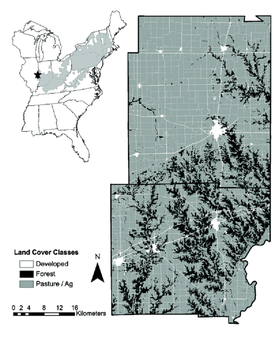
Distribution, Abundance and Habitat Use of Jefferson Salamander: a threatened species with a restricted range in Illinois
Jefferson salamanders (Ambystoma jeffersonianum) are vernal pool-breeding salamanders that inhabit deciduous forests in eastern North America. These salamanders are locally rare, occur in small population sizes, and are considered a species of conservation concern over portions of their range. Jefferson salamanders were not documented in Illinois until 1990, and subsequently listed as a state threatened species because of their restricted range and dependence or rare and vulnerable habitat in a highly fragmented landscape. From their discovery in 1990 through 2007, Jefferson salamanders were documented from fewer than ten localities along the Illinois-Indiana border in Clark and Edgar Counties, with one disjunct population in a state managed park. For this study, we used species distribution and occupancy modeling in unison to direct survey efforts, provide estimates of species presence/absence and identify local and landscape features important for Jefferson Salamander occurrence. We documented 29 new breeding ponds for the species in Illinois and were able to confirm the continued presence of the species at four of the eight historical sites we sampled.
Jefferson salamanders (Ambystoma jeffersonianum) are vernal pool-breeding salamanders that inhabit deciduous forests in eastern North America. These salamanders are locally rare, occur in small population sizes, and are considered a species of conservation concern over portions of their range. Jefferson salamanders were not documented in Illinois until 1990, and subsequently listed as a state threatened species because of their restricted range and dependence or rare and vulnerable habitat in a highly fragmented landscape. From their discovery in 1990 through 2007, Jefferson salamanders were documented from fewer than ten localities along the Illinois-Indiana border in Clark and Edgar Counties, with one disjunct population in a state managed park. For this study, we used species distribution and occupancy modeling in unison to direct survey efforts, provide estimates of species presence/absence and identify local and landscape features important for Jefferson Salamander occurrence. We documented 29 new breeding ponds for the species in Illinois and were able to confirm the continued presence of the species at four of the eight historical sites we sampled.

Collaborators: John A. Crawford & William E. Peterman
Sponsor: Illinois Department of Natural Resources Wildlife Preservation Fund
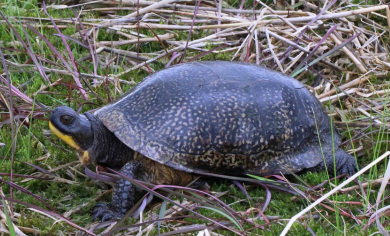
Status of Blanding’s Turtle in Lake County Forest Preserve District and Feasibility of Initiating a Head-Starting Program
This was a six year project with many constantly morphing objectives. It was initiated as a survey of 8 LCFPD properties for the presence of Blanding’s Turtles. From there it morphed into a demographic and spatial ecology study of the largest currently known population of Blanding’s Turtle in Illinois. We conducted extensive (nearly daily) radio-telemetry studies of hatchlings, head-started, juvenile, and adult Blanding’s Turtles to estimate movements, home-range size, clutch size and frequency, nest predation rates, both ex-situ (by artificially incubation) and in-situ (via predator exclusion fences) nest protection protocols, survival rates of hatchlings (in the head-starting program and in the wild) and adults, population estimates, etc. Additionally, following the initial models done by Chris Benda (2006 M.S. U of I), I modeled different scenarios for the implementation of a head-starting program for Blanding’s Turtle.
This was a six year project with many constantly morphing objectives. It was initiated as a survey of 8 LCFPD properties for the presence of Blanding’s Turtles. From there it morphed into a demographic and spatial ecology study of the largest currently known population of Blanding’s Turtle in Illinois. We conducted extensive (nearly daily) radio-telemetry studies of hatchlings, head-started, juvenile, and adult Blanding’s Turtles to estimate movements, home-range size, clutch size and frequency, nest predation rates, both ex-situ (by artificially incubation) and in-situ (via predator exclusion fences) nest protection protocols, survival rates of hatchlings (in the head-starting program and in the wild) and adults, population estimates, etc. Additionally, following the initial models done by Chris Benda (2006 M.S. U of I), I modeled different scenarios for the implementation of a head-starting program for Blanding’s Turtle.

Collaborators: Gary Glowacki & Christopher A. Phillips
Sponsors: Illinois Department of Natural Resources State Wildlife Grant &
Private Trust to Lake County Forest Preserve District
